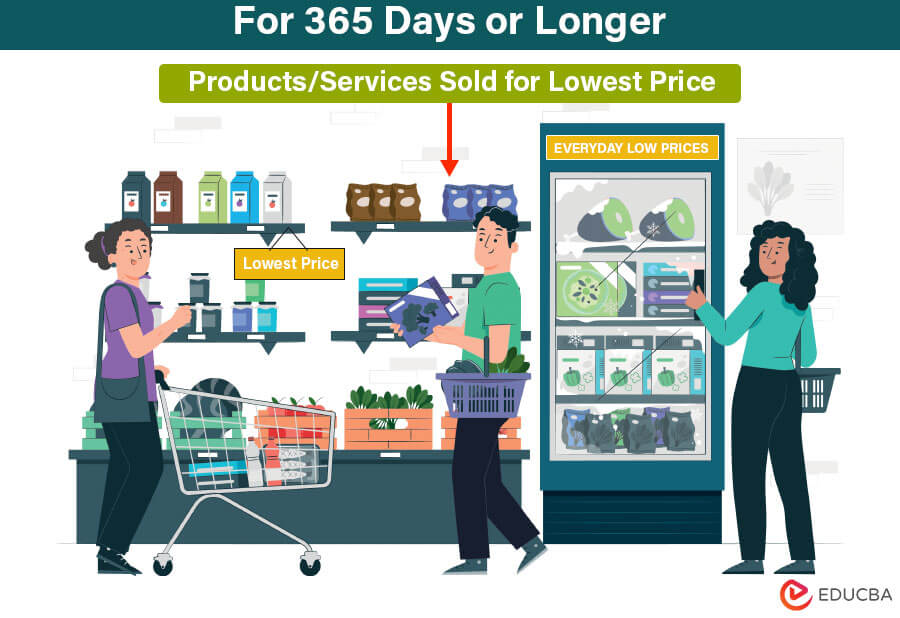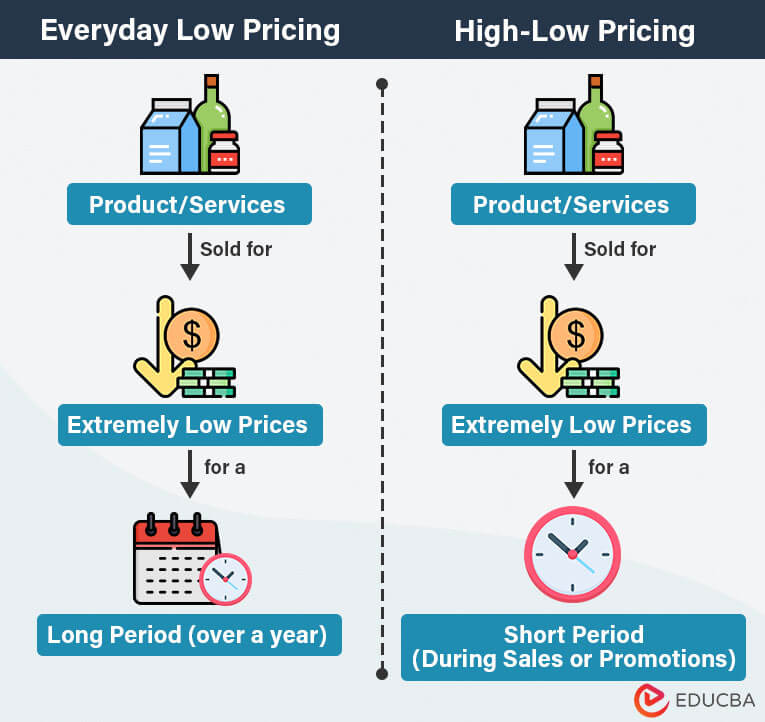
What is an Everyday Low Pricing (EDLP) Strategy?
Everyday Low Pricing (EDLP) is when businesses sell their products and services at constantly low prices for a longer period of time.
Companies use this pricing strategy to give their customers an option to buy essential as well as luxury products at consistent and low prices. This way, customers will be more likely to buy goods from the respective business, and the company’s customer loyalty will increase.
Table of Contents
Key Highlights
- Everyday Low Pricing (EDLP) means businesses keep their prices consistently low for a long time.
- Retailers adopt this strategy to provide consistent and reasonable pricing on their goods, promoting affordability and customer satisfaction.
- This approach simplifies the shopping experience, as customers can rely on predictable and fair prices.
- One major disadvantage of EDLP is that it might have a negative impact on profit margins, as every other product is priced low.
Real-Life Examples
Here are some real company examples of everyday low pricing:
Example #1: Walmart
One of the most common examples is Walmart. This retail store has everyday low prices all year long on different products such as groceries, electronics, clothing, and other necessities.
Example #2: Amazon
Amazon is well-known for its aggressive pricing strategy, including offering various products at low prices. The company achieves this by working efficiently and keeping its operating costs low.
Example #3: Dollar General
Dollar General is a discount retailer that offers everyday low prices on various products. The company achieves this by operating efficiently and keeping overhead costs low.
Case Study: Aldi Grocery Stores
Overview of Aldi’s EDLP Pricing Strategy:
Since its establishment, Aldi grocery stores aimed to build immense customer loyalty by selling groceries of great quality at the lowest prices. For more than 20 years, Aldi has used the everyday low pricing strategy in US stores to sell its branded grocery products at low prices.
How?
Here are some reasons how Aldi can make profits even after selling products at lower costs.
- They work directly with suppliers to remove any middlemen from the supply chain, like distributors, manufacturers, etc.
- They also focus on simpler store layouts, which have no shelves, fewer registers, etc.
- Moreover, they encourage customers to bring their own bags (BYO bags) to save costs.
New Hybrid Pricing Strategy:
Until 2019, Aldi only had one pricing strategy: EDLP (offering products at consistently low prices). But in 2019, they started using a combination of both EDLP and high-low pricing strategy. This was to help their business grow faster.
In this strategy, every once in a while, Aldi puts a few products on Super Saver discount, selling them at prices lower than their usual ELDP prices.
Aldi has been continuously growing, consistently opening new stores in different parts of the world.
Why Do Businesses Use EDLP?
Here is the rationale behind businesses implementing the EDLP pricing strategy.
- Customer loyalty: EDLP helps businesses build customer loyalty. Customers understand that they can rely on low prices, which leads to repeated purchases from the business.
- Reducing Market costs: Firms don’t need to spend as much money on advertising as required for other pricing strategies. This reduces the firm’s overall marketing costs.
- Increased sales volume: Firms will attract more price-sensitive customers by offering consistently lower prices. Over time, this can increase sales volume.
- Competitive advantage: Using an EDLP strategy can help your company stand out from competitors who rely on frequent sales and promotions.
- Operational efficiency: By eliminating the need for frequent pricing adjustments and promotions, EDLP can help streamline operations and reduce costs. This leads to increased efficiency and profitability.
How Do Businesses Use EDLP?
Here is how companies use the everyday low-pricing strategy:
- Set a starting point price: Firms sell products at a value that is lower than the product’s usual price but not too low that the firm has to face any losses.
- Reduce costs: To keep prices low, firms cut costs by streamlining operations, negotiating better deals with suppliers, and seeking ways to reduce wasteful spending.
- Explain your strategy: The company promotes its EDLP strategy through various marketing channels. They craft a very clear message to show customers that the prices are consistently low.
- Maintain consistency: After establishing the baseline price, the company sticks to it throughout the year or longer, with no temporary or seasonal adjustments.
Everyday Low Price Vs. High-Low Pricing
| Particulars | Everyday Low Price | High Low Pricing |
| Definition | EDLP means maintaining a consistent and low price for products throughout the year. | High-low pricing involves selling products at prices lower than competitors but only for a small period (sales or promotional period). |
| Profit Margins | Businesses have lower profit margins per sale but higher overall sales volume. | Businesses have higher profit margins during non-discount periods, compensating for lower margins during promotional events. |
| Marketing Costs | Typically lower as there are fewer sales and promotions. | Typically higher as there are frequent sales and promotions. |
| Customer Experience | Consistent low prices every day build customer’s trust. | Sense of urgency and excitement during promotional periods. |
| Customer Loyalty | Builds long-term customer loyalty. | May not build long-term customer loyalty. |
| Inventory Management | Minimizes inventory waste. | Can lead to excess inventory during non-promotional periods. |
Advantages and Disadvantages
Given are the advantages and disadvantages of using the EDLP strategy,
| Advantages | Disadvantages |
| It simplifies the pricing process for the business, eliminating the need for frequent changes. | Without temporary discounts, there may be less urgency for customers to make impulse purchases. |
| Having a loyal customer base helps businesses maintain long-term profitability. | During periods of intense promotional activity, businesses practicing EDLP may face a competitive disadvantage. |
Frequently Asked Questions (FAQs)
Q1. Who uses EDLP?
Answer: EDLP is the most common technique that retailers often use. Retail stores like Walmart, Dollar General, Costco, etc., use EDLP to offer low prices on most products.
Q2. Can businesses use EDLP in association with other pricing strategies?
Answer: Yes, companies can use EDLP with other pricing strategies, such as bulk discounts or dynamic pricing for seasonal products.
Q3. How should businesses go about implementing EDLP?
Answer: Businesses should consider the potential benefits and drawbacks before implementing EDLP as a pricing strategy. They should also test and monitor the impact of EDLP on their business and make adjustments as needed.
Recommended Articles
We hope that this EDUCBA guide on Everyday low pricing (EDLP) strategy has helped you. For more guidance and economic-related articles, read these recommendations:


